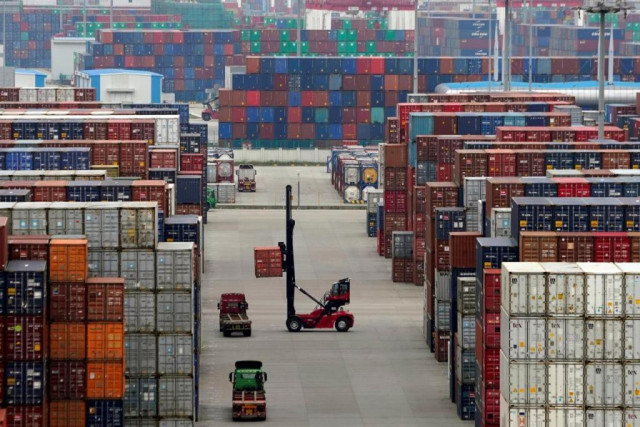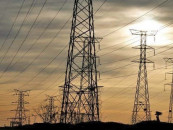Pakistan needs to go for high value-added export basket
Capital inflows in form of export receipts are less than outflows in shape of import payments

Capital inflows in form of export receipts are less than outflows in shape of import payments. PHOTO: REUTERS
If an economy’s terms of trade are less than 100%, they are regarded as adverse. This signifies that capital inflows into the economy in the form of export receipts are less than capital outflows in the form of import payments.
In the case of Pakistan, like most other non-oil exporting developing countries, both trade balance and terms of trade have remained adverse, which shows that not only we import more than we export, but on balance our exports are much cheaper than imports.
Gwadar will soon be the centre of global trade
This is hardly surprising, because Pakistan is essentially an exporter of primary products, such as rice, and low-technology goods, which are derived from products such as textile and leather articles. On the other hand, our imports comprise largely fuels, such as crude oil, consumer products, and capital goods and machinery.
Prices of non-oil primary products are generally much lower and prices of low-technology goods are less than those of machinery and equipment (the high and medium-technology products).
Pakistan’s terms of trade problem is compounded by the fact that commodity-based products that it exports are also low-priced because they have low value addition and technology content, lack product upgrade and sophistication, are labour-intensive (unskilled) and are sold to the low end of the market.
In the case of developing countries, which depend on non-oil primary products for export earnings, the terms of trade tend to deteriorate over time. In the last one decade from fiscal year 2008 to 2017 – full-year data for FY18 is not yet available, Pakistan recorded the overall annual average terms of trade of 55.82%. However, in the preceding decade (FY1998-2007), the average terms of trade were 88.26%, according to the Pakistan Bureau of Statistics (PBS).
The data shows a sharp deterioration in the terms of trade over the years. In FY17, Pakistan’s terms of trade stood at 57.17%, which suggests that Pakistan’s average export prices are nearly half the import prices. When a country faces a gap so large between its export and import prices, the only way it can avoid a substantial trade deficit is to drastically increase the quantity of exports.
However, this requires a large exportable surplus, which Pakistan does not have. Besides, an increase in export supplies tends to depress their prices. Hence, it has not been possible for Pakistan to compensate for low export prices by increasing export supplies.
On a disaggregate level, it is only in the primary sectors, such as food and fuels, that Pakistan’s terms of trade have been mostly more than 100% each. In the value-added sector, notably manufactures, and machinery and transport equipment, the terms of trade have been mostly adverse.
The fact that Pakistan has had favourable terms in case of primary products and adverse terms in case of value-added products seems to be a paradox. It only shows that primary products Pakistan exports on average carry a higher price than primary products it imports.
Conversely, chemicals, manufactured goods and capital and transport equipment that Pakistan imports on average carry a much higher price than that for the products of the same categories it exports.
Better trade terms
Favourable or improved terms of trade enable a country to buy a larger quantity of goods in exchange for a smaller quantity of exports. Since exports raise prices in the domestic market due to reduced supply of goods, they reduce consumer welfare and enhance producer welfare.
On the other hand, imports increase consumer welfare and reduce producer welfare. A country’s overall welfare is a function of both consumer and producer welfare.
The favourable terms of trade, which allow a country to earn high export revenues by selling a smaller quantity of products to foreigners, thus increase overall welfare in an economy. The exchange of relatively small quantities of exports for relatively large quantities of imports also allows a country to raise the living standards of the people.
The terms of trade also bear upon economic growth and development. Being a developing country, Pakistan needs to import machinery, equipment and intermediate goods in sufficient quantities to maintain the growth momentum. Oil and other petroleum products are necessary to keep the wheels of the economy moving.
Pakistan, Egypt agree to promote trade, economic cooperation
Since exports are the principal source of earning foreign exchange, adverse terms of trade have constrained the ability to import industrial goods and raw material in sufficient quantities, which have slowed down the growth momentum.
A high trade deficit, which is underpinned by both high import prices relative to export prices and import quantities, is politically disturbing for the government, which is forced to adopt measures such as regulatory duties and restricting imports including those which are needed by the domestic industry. At any rate, the increase in import prices hits the consumer hard.
Besides, export revenue is an important source of savings. When businesses earn low revenue per unit of exports, they are deficient in the funds required for capital formation, which discourages private-sector investment. Adverse terms of trade may also cause balance of payments problems.
Countries, which rely on primary products for exports or otherwise have a high export concentration ratio, are especially vulnerable to terms of trade-induced balance of payments shocks.
In the case of Pakistan, a fall in world commodity prices often worsens the terms of trade and exacerbates the trade imbalance, thus leading to balance of payments problems. In order to improve the terms, the country needs to move towards a high value-added and rich technology content export basket.
The writer is an Islamabad-based columnist
Published in The Express Tribune, October 22nd, 2018.
Like Business on Facebook, follow @TribuneBiz on Twitter to stay informed and join in the conversation.



















COMMENTS
Comments are moderated and generally will be posted if they are on-topic and not abusive.
For more information, please see our Comments FAQ